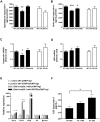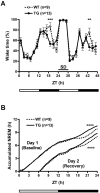IGFBP3 colocalizes with and regulates hypocretin (orexin)
- PMID: 19158946
- PMCID: PMC2617764
- DOI: 10.1371/journal.pone.0004254
IGFBP3 colocalizes with and regulates hypocretin (orexin)
Abstract
Background: The sleep disorder narcolepsy is caused by a vast reduction in neurons producing the hypocretin (orexin) neuropeptides. Based on the tight association with HLA, narcolepsy is believed to result from an autoimmune attack, but the cause of hypocretin cell loss is still unknown. We performed gene expression profiling in the hypothalamus to identify novel genes dysregulated in narcolepsy, as these may be the target of autoimmune attack or modulate hypocretin gene expression.
Methodology/principal findings: We used microarrays to compare the transcriptome in the posterior hypothalamus of (1) narcoleptic versus control postmortem human brains and (2) transgenic mice lacking hypocretin neurons versus wild type mice. Hypocretin was the most downregulated gene in human narcolepsy brains. Among many additional candidates, only one, insulin-like growth factor binding protein 3 (IGFBP3), was downregulated in both human and mouse models and co-expressed in hypocretin neurons. Functional analysis indicated decreased hypocretin messenger RNA and peptide content, and increased sleep in transgenic mice overexpressing human IGFBP3, an effect possibly mediated through decreased hypocretin promotor activity in the presence of excessive IGFBP3. Although we found no IGFBP3 autoantibodies nor a genetic association with IGFBP3 polymorphisms in human narcolepsy, we found that an IGFBP3 polymorphism known to increase serum IGFBP3 levels was associated with lower CSF hypocretin-1 in normal individuals.
Conclusions/significance: Comparison of the transcriptome in narcolepsy and narcolepsy model mouse brains revealed a novel dysregulated gene which colocalized in hypocretin cells. Functional analysis indicated that the identified IGFBP3 is a new regulator of hypocretin cell physiology that may be involved not only in the pathophysiology of narcolepsy, but also in the regulation of sleep in normal individuals, most notably during adolescence. Further studies are required to address the hypothesis that excessive IGFBP3 expression may initiate hypocretin cell death and cause narcolepsy.
Conflict of interest statement
Figures




Similar articles
-
Narp immunostaining of human hypocretin (orexin) neurons: loss in narcolepsy.Neurology. 2005 Oct 25;65(8):1189-92. doi: 10.1212/01.wnl.0000175219.01544.c8. Epub 2005 Aug 31. Neurology. 2005. PMID: 16135770 Free PMC article.
-
Elevated Tribbles homolog 2-specific antibody levels in narcolepsy patients.J Clin Invest. 2010 Mar;120(3):713-9. doi: 10.1172/JCI41366. Epub 2010 Feb 15. J Clin Invest. 2010. PMID: 20160349 Free PMC article.
-
Hypocretin/orexin and narcolepsy: new basic and clinical insights.Acta Physiol (Oxf). 2010 Mar;198(3):209-22. doi: 10.1111/j.1748-1716.2009.02012.x. Epub 2009 Jun 25. Acta Physiol (Oxf). 2010. PMID: 19555382 Free PMC article. Review.
-
Anti-Tribbles Pseudokinase 2 (TRIB2)-Immunization Modulates Hypocretin/Orexin Neuronal Functions.Sleep. 2017 Jan 1;40(1). doi: 10.1093/sleep/zsw036. Sleep. 2017. PMID: 28364459
-
The hypocretin/orexin system in health and disease.Biol Psychiatry. 2003 Jul 15;54(2):87-95. doi: 10.1016/s0006-3223(03)00349-4. Biol Psychiatry. 2003. PMID: 12873797 Review.
Cited by
-
Loss of survival factors and activation of inflammatory cascades in brain sympathetic centers in type 1 diabetic mice.Am J Physiol Endocrinol Metab. 2015 Apr 15;308(8):E688-98. doi: 10.1152/ajpendo.00504.2014. Epub 2015 Feb 24. Am J Physiol Endocrinol Metab. 2015. PMID: 25714673 Free PMC article.
-
Hypocretin neuron-specific transcriptome profiling identifies the sleep modulator Kcnh4a.Elife. 2015 Oct 1;4:e08638. doi: 10.7554/eLife.08638. Elife. 2015. PMID: 26426478 Free PMC article.
-
Epigenetic silencing of selected hypothalamic neuropeptides in narcolepsy with cataplexy.Proc Natl Acad Sci U S A. 2023 May 9;120(19):e2220911120. doi: 10.1073/pnas.2220911120. Epub 2023 May 1. Proc Natl Acad Sci U S A. 2023. PMID: 37126681 Free PMC article.
-
Animal models of narcolepsy and the hypocretin/orexin system: Past, present, and future.Sleep. 2021 Jun 11;44(6):zsaa278. doi: 10.1093/sleep/zsaa278. Sleep. 2021. PMID: 33313880 Free PMC article.
-
Evolutionarily conserved regulation of hypocretin neuron specification by Lhx9.Development. 2015 Mar 15;142(6):1113-24. doi: 10.1242/dev.117424. Epub 2015 Feb 27. Development. 2015. PMID: 25725064 Free PMC article.
References
-
- Mignot E, Lammers GJ, Ripley B, Okun M, Nevsimalova S, et al. The role of cerebrospinal fluid hypocretin measurement in the diagnosis of narcolepsy and other hypersomnias. Arch Neurol. 2002;59:1553–1562. - PubMed
-
- Sakurai T, Amemiya A, Ishii M, Matsuzaki I, Chemelli RM, et al. Orexins and orexin receptors: a family of hypothalamic neuropeptides and G protein-coupled receptors that regulate feeding behavior. Cell. 1998;92:1 page following 696. - PubMed
-
- Chemelli RM, Willie JT, Sinton CM, Elmquist JK, Scammell T, et al. Narcolepsy in orexin knockout mice: molecular genetics of sleep regulation. Cell. 1999;98:437–451. - PubMed
-
- Lin L, Faraco J, Li R, Kadotani H, Rogers W, et al. The sleep disorder canine narcolepsy is caused by a mutation in the hypocretin (orexin) receptor 2 gene. Cell. 1999;98:365–376. - PubMed
Publication types
MeSH terms
Substances
Grants and funding
LinkOut - more resources
Full Text Sources
Molecular Biology Databases
Research Materials
Miscellaneous

